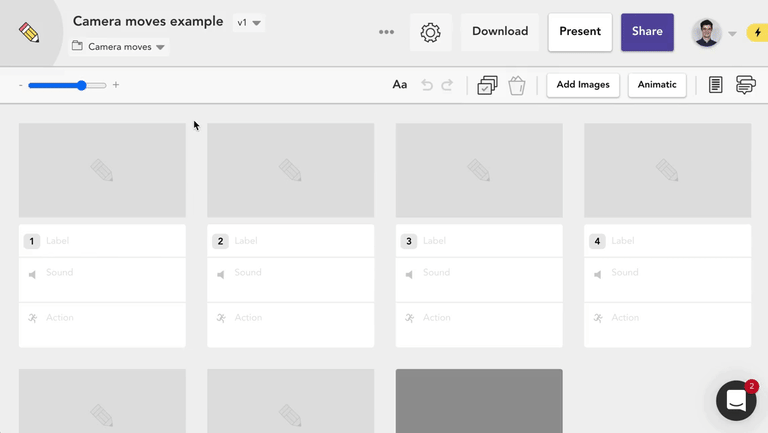What Type Of Camera Movement Swivels The Camera On A Vertical Axis
The sixteen Types of Camera Shots & Angles (Video Guide)

Karen Mc Guinness, Client Success Specialist
Do you sometimes experience like your vision for a film is lost in translation? It can be a frustrating experience, but i that tin can be avoided (or at to the lowest degree minimised). Earlier you move on to more advanced video transitions or animatics, a solid understanding of storyboarding fundamentals volition take you a long way.
Armed with a working cognition of camera shots, angles, and perspective techniques, you'll be well on your manner to creating easy-to-read storyboards, which communicate your vision as you intended information technology. To that stop, we've pulled together sixteen camera moves and shot types to give your storyboarding vocabulary a heave.
Go this guide as a poster
Basic Camera Moves
Past incorporating a variety of different camera moves into your shots, you lot tin can add a deeper sense of visual interest. Combine this with a strategic approach to messaging and you'll be off to the races. As with deciding how to frame your shots, take care when selecting the near advisable camera move. The effect that each move has can vary significantly in how information technology makes the viewer feel.
Here are some well-loved camera moves to consider:
Zoom

Probably the most well-known camera move, zooming gives the impression of moving closer or farther away from the subject field. It can be used effectively to magnify a certain focus bespeak in the frame, only other moves such as a dolly, are a more natural fashion to show motility. While a quick zoom tin can aid add together a sense of drama and energy when used correctly, avert over-using zoom as your default move.
Also if you're making a storyboard, Boords has pre-built indicators for Zooming (likewise as a bunch of other common camera moves). Merely click Insert Camera Move in the Image Editor:

Pan

Panning is when the camera is moved horizontally from one side to another on a primal axis. This is a rotating movement in which the camera's position remains in place, but the direction that information technology faces changes. It can be used to follow a moving grapheme or to fit more than into a frame, for example, panning across a landscape to create a sense of place.
Storyboarding and animatics for modern video teams. Go organized, produce your best work.
Tilt

Tilting is similar to panning in that the camera is kept in a stationary position, but unlike panning (which looks from side to side) tilting focuses on upwards & downwards movements. Using a tilting motility helps to fit more than into a unmarried frame. A deadening upward tilt can exist very effective in making a subject appear bigger or more significant while a down tilt has the opposite consequence.
Dolly

A dolly shot is when the unabridged photographic camera is mounted on a track and is moved towards or away from a discipline. Different a zoom shot, the world around the discipline moves with the photographic camera. A dolly gives the illusion that the viewer is walking towards the subject field and can be a great mode of creating a sense of intimacy between them.
Truck

Similar to dollying, trucking involves moving the entire camera forth a fixed point, merely the motion goes from side to side, rather than in and out. Information technology'due south often used to follow characters in activity. Mounting the camera on a fluid motion track will aid to stamp out any jerking camera movements.
To add a truck indicator in Boords, just select Pan right from the Camera Movements menu in the Paradigm Editor:

Pedestal

A pedestal (AKA Nail up/down or Jib upward/downward) involves moving the camera upwards or downwards in relation to a subject field. It's different from tilting in that the unabridged camera ascends or descends, rather than only the bending of the camera. A pedestal shot can be used to frame a alpine or high subject field (such equally a building) while keeping the framing at eye level view for the viewer.
Go the Ultimate PDF Storyboard Template Packet
x professionally designed storyboard templates equally ready-to-use PDFs.
Storyboarding Shot Types
There are many means to frame a subject within a shot, which tin range from showing their unabridged body to fixating on a finer item, such as their eyes. In choosing the about plumbing fixtures shot, you'll need to bear in mind the bulletin that you're trying to communicate to your audience.
Here are some of the most mutual types of shots and how you tin can go well-nigh using them:
Establishing shot

Frequently included at the beginning of a scene, the establishing shot helps to build ambiance and may requite a nod towards the context of what's to come up. Information technology by and large comes in the course of a long shot and indicates where (and sometimes when) the scene is taking identify.
Full shot

The full shot is just as the proper name implies and shows the entire torso of the subject from head to toe. This shot tends to focus more on the character'due south motility and gestures, rather than their country of mind.
Medium shot

Besides known as the ¾ shot, the medium shot typically shows the subject from the knees up. Information technology allows the viewer to see the background environment and the character's gestures, while nevertheless being close plenty to capture their emotions.
Become this guide as a poster
Shut shot

With a close shot, the subject's head/face takes up the majority of the frame and therefore, allows their reactions and emotions to dictate the scene. The subject becomes the prominent focus and helps the audience build a personal connexion, without being distracted by background interferences.
Extreme shut shot

An extreme close shot is and then close that merely one specific item, such as a person's eyes or oral cavity, can be seen. Because of the unnaturally shut nature of the shot, it should exist used sparingly, but when used appropriately, an ECS can be incredibly effective at calculation drama to a scene. It allows the viewer to come across details that may accept otherwise gone unnoticed and can really accentuate the emotions that the subject is experiencing.
Up shot

An upward shot is taken from beneath the eye-level of the subject field and creates the perception that the viewer is looking at them from a lower perspective. This type of shot tin can requite the impression that the subject field is in some style powerful, heroic or even dangerous.
Downwards shot

A downwards shot, in contrast to an upwards shot, is taken from above the eye-level of the field of study and tin brand the subject seem vulnerable or powerless.
Over the shoulder shot

This type of shot is taken from behind the shoulder of another grapheme and typically frames the subject in a medium or close shot. It is particularly effective in group conversation scenes and helps institute which characters are speaking to each other.
Storyboarding and animatics for modern video teams. Get organized, produce your best work.
2 shot

A two shot presents two characters together within the same frame. It's a natural means of introducing both people and can be used to shed light on their relationship with one some other. Different variations of the 2 shot tin can be applied to deliver different messages about the characters. For example, when characters are positioned next to each other, it may give the impression that they take equal prominence within the scene.
Point of view shot

The point of view shot, also known as the POV shot, depicts an angle that shows what a character is looking at. This type of shot allows the viewer to take on the perspective of the character and begin to empathise their state of mind on a more personal level.
Applying this to your storyboards
While a picture oftentimes speaks a grand words, being precise with your language tin can really make the difference when it comes to storyboarding. Keep it uncomplicated however specific, and you lot'll be on rail to a brilliant animatic and beyond.
What are some of your favourite shots to work with? Ever had an experience of ideas getting lost in translation? Tell the states about them in the comments.
Source: https://boords.com/blog/16-types-of-camera-shots-and-angles-with-gifs
Posted by: flynncrue1941.blogspot.com

0 Response to "What Type Of Camera Movement Swivels The Camera On A Vertical Axis"
Post a Comment